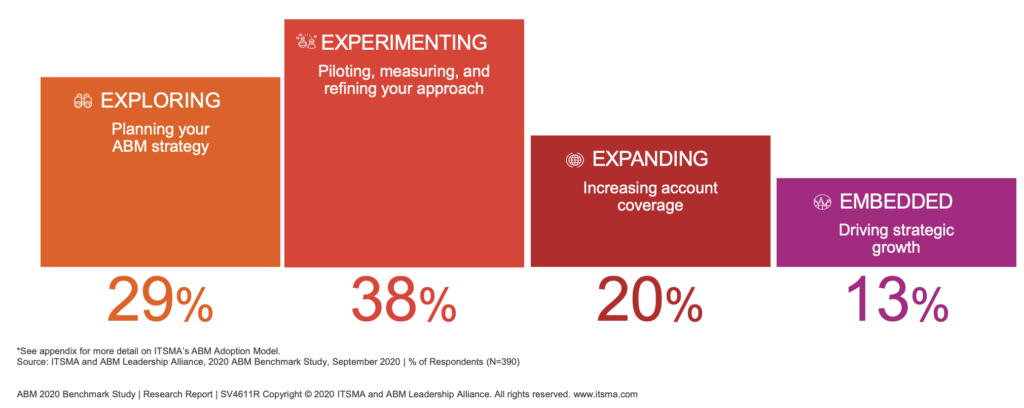Developing your best marketing strategy is a challenge. Markets change almost continuously, driven by the changing behaviors of buyers in both B2C and B2B markets. Buyers want more than products, solutions and services – they demand exceptional buying experiences centered on increasingly personalized buying journeys.
You’re either considering account-based marketing (ABM) strategies or looking to refine your existing ABM go-to-market (GTM) motions. Congratulations – you’re far from being alone. Standardized, one-size-fits-all marketing strategies are becoming obsolete, and in the B2B space, businesses are adopting ABM strategies like never before. However, there’s still a long way to go.
Account-based marketing has been around for some time now, but to date, it’s adoption has hit a few roadblocks. Despite studies showing higher customer engagement and bigger deal sizes with ABM, the ABM Leadership Alliance 2020 benchmark study showed that over half of respondents are only exploring or experimenting with ABM, and only 13 percent described their ABM programs as fully embedded and a driver of strategic growth.
Implementation of ABM often bogs down as companies discover the challenges inherent in so many out-of-the box solutions, including:
-
- Ensuring an alignment between Sales and Marketing functions
- Selecting the right targeted accounts
- Curating the best content for engagement
- Delivering personalized customer experiences
- Creating a scalable ABM strategy
This post covers the differences between an ABM framework and that of a more traditional demand generation (demand gen) process, and then delves into answers on how to best utilize your Salesforce CRM to fuel your ABM motions, aligning your best marketing and selling resources to your best GTM opportunities.
ABM vs. Demand Gen
First off, what’s the difference between demand gen and ABM?
Demand generation is exactly what it says – generating demand for a business’ products, solutions and/or services. Typically, demand gen is operationalized through a comprehensive process across the entire Marketing function, with an emphasis on driving increased awareness and interest in the company and its value proposition. Demand gen is most often used by B2B companies to optimize their lead generation channels, particularly inbound methodologies like content marketing, social media engagement, and search engine optimization (SEO). Demand gen activities are measured by the volume and cost of leads generated.
Conversely, account-based marketing, sometimes referred to as key account marketing, is a strategic marketing approach centered on account awareness, where a business concentrates its assets and resources on a set of targeted accounts within a market. ABM represents perhaps the ultimate level of integration between Marketing and Sales, and moves beyond a concentration on inbound content generating leads toward orchestrated outbound tactics to generate a complete view of targeted accounts with multiple contacts, intent and paths to success.
Truth be told, in practice, B2B companies usually go to market with a hybrid strategy, starting with building a demand gen process to power growth. Then, while fine-tuning the demand gen engine, organizations add on ABM motions to scale market penetration and revenue growth.
Both demand gen and ABM strategies share many tactics, like content-rich campaigns using methodologies like email nurture campaigns and paid search advertising like pay-per-click (PPC) and display ads. Layering ABM on top of demand gen allows you to build out your GTM strategy and better position yourself to seize marketplace opportunities. Below are tips to get you started.
What is Required for ABM in Salesforce?
Before you jump into an ABM process you and your team will have to complete a handful of prerequisites to be effective:
-
- Create a well-mapped account list
- Curate a collection of multichannel content assets,
- Determine clear calls-to-action (CTAs) on all outreach activities
- Define a comprehensive follow-up strategy
Most importantly, your teams will need a clean data infrastructure to succeed in your ABM efforts. Without a solid foundation of account and contact data in Salesforce, your ABM campaigns will be unorganized from the very start, confusing your Sales team and greatly limiting the efficiency, and ultimately the effectiveness, of your processes.
As the GTM motion is account-based, the place you need to start is with the account object in Salesforce.
SFDC Lead-to-Account Matching
The biggest thing for your Marketing team to adapt to with ABM is shifting from a paradigm of prospecting leads to one of prospecting contacts and accounts. Fortunately, you likely already have a great many account-associated leads already in your Salesforce (SFDC) system.
LeanData’s Lead-to-Account Matching solution, a native Salesforce application, uses a best-in-class fuzzy matching algorithm to analyze leads and match them to existing accounts in your SFDC instance. With it, you define your own rules for the most accurate match, and ensure multiple account matches, complex parent-child account hierarchies and duplicate accounts are handled the way your team prefers.
Matching gives your Sales and Marketing teams a holistic view of the account and arms them with the context needed to accelerate their ABM activities. There’s no need for your teams to spend any additional time researching and triaging lead data.
Additionally, your Marketing team might also use a third-party data tool like Zoominfo to enrich the data you collect and share for your accounts. However, depending on the process you use for importing into Salesforce, it’s quite possible your accounts are missing valuable fields of information that would help you determine if they match your Ideal Customer Profile (ICP).
As you assess your ABM strategy, ensure you’re determining the key attributes that make up your ICP – industry segment, annual revenue, number of employees and the like. Depending on your ICP criteria, you may discover you have to add custom data fields to your Salesforce records.
If your teams use a data provider that integrates with Salesforce, you can easily control the field mapping from within your instance. However, if your tech stack demands a reliance on manual list imports, you’ll need to ensure your spreadsheet columns are precisely and correctly labeled to match the corresponding fields in Salesforce. A pro tip here is to create a list import template with the correct headers for Salesforce, then format your CSV file with those columns before importing.
How to Automate Account-Based Marketing in Salesforce
When it comes to ABM, Salesforce generally meets the needs of your Sales and Marketing team with its product solutions, including Marketing Cloud and Pardot marketing automation, and its proprietary artificial intelligence (AI) solution, Einstein.
The Salesforce suite promises to elevate your ABM motion, and its solutions can greatly assist you in the following critical functions:
-
- Identifying key accounts. Salesforce’s Einstein AI application scours your CRM data, external data, and engagement data to determine your best accounts, allowing your teams to focus on high-value targets.
- Engaging buyers. Personalizing every message delivered at every touchpoint paves the way to acquire new prospects from target accounts and nurture further through the customer journey.
- Delivering connected engagements. Aligned Sales and Marketing teams use real-time data and shared templates to work toward common goals and objectives.
- Growing customer relationships. Measuring the success of your ABM campaigns and tracking how targeted accounts are moving through the funnel allows you to refine and continuously improve your campaigns over time.
Critical to ABM success is the effective routing of leads, contacts and accounts, as it empowers revenue teams to action its matched data in Salesforce.
How LeanData Does ABM in Salesforce
As mentioned previously, LeanData is a native Salesforce application, meaning it is built completely within Salesforce itself using the Lightning platform and, therefore, doesn’t require integration with Salesforce through an API. As such, all of your valuable customer data never leaves the security of your instance of Salesforce.
Within Salesforce, LeanData Matching maps leads to accounts, providing a comprehensive, holistic overview of each account opportunity. Whether enriched with data from Zoominfo or another, or coupled with information from tools like LinkedIn Sales Navigator, your Sales teams can surgically target prospects at your most valuable customer accounts.
After matching leads to accounts, LeanData account-based lead routing then routes each lead to the appropriate representative at the right time so that your team can get to selling – and closing – as soon as possible.
Getting started with ABM today
Account-based marketing is a strategy that joins data management with marketing automation to create personal campaigns for the targeted accounts you most desire to engage. When you look to scale with ABM, you need to know exactly what leads and contacts to go after, how to keep track of them, who to assign leads to, and when to go engage with them. To do that, you need not only the right mindset and skill set, but also the right tool set.
Whether you’re an established enterprise with an army of marketers or a new startup with a Marketing team of one, you can use the ABM principles above to get your ABM motion started today and optimize your GTM strategies to scale your business.










